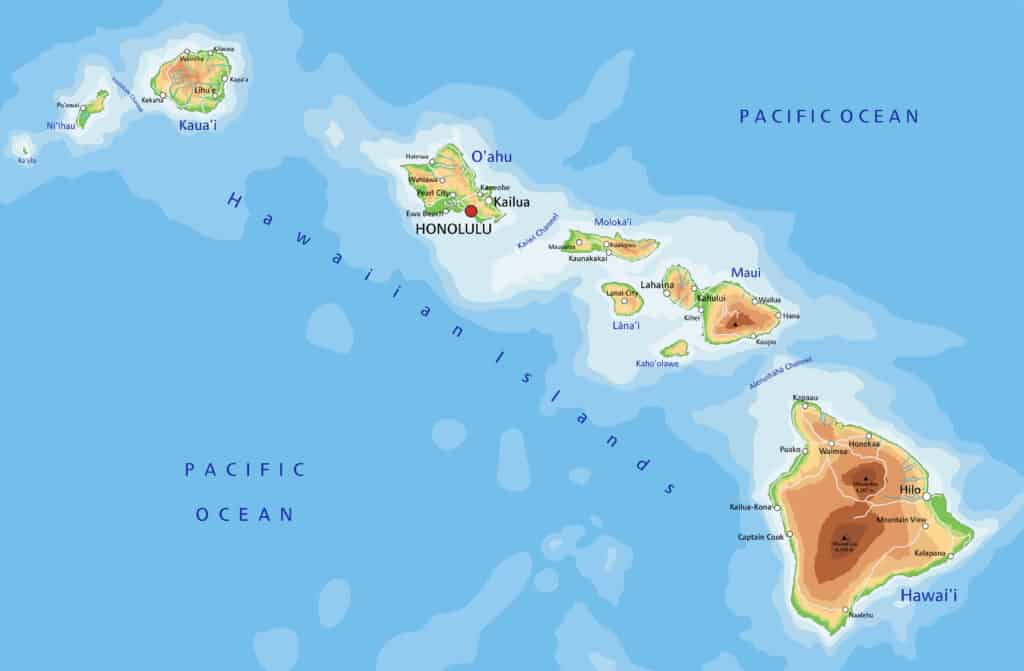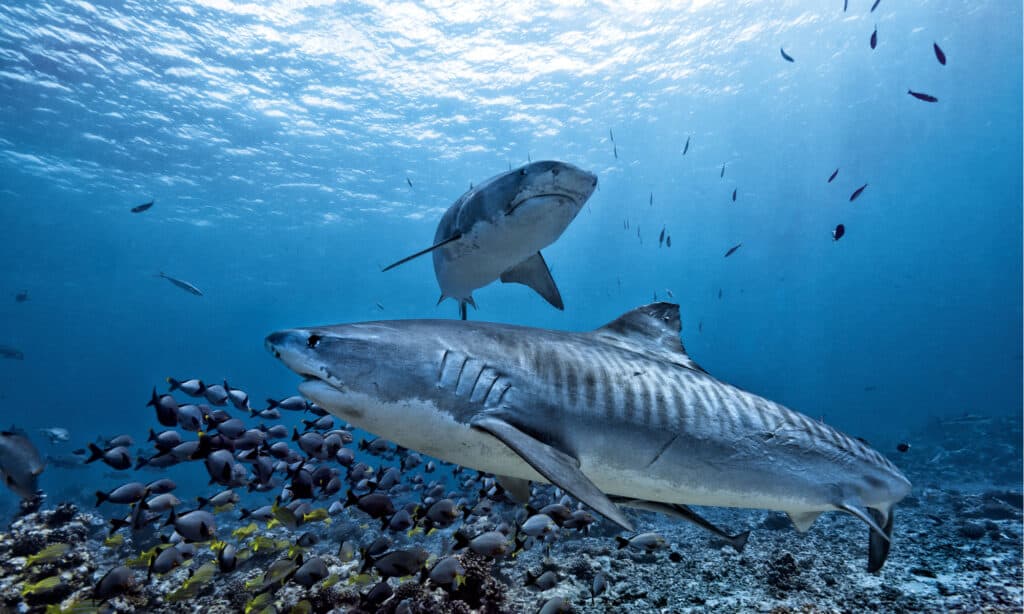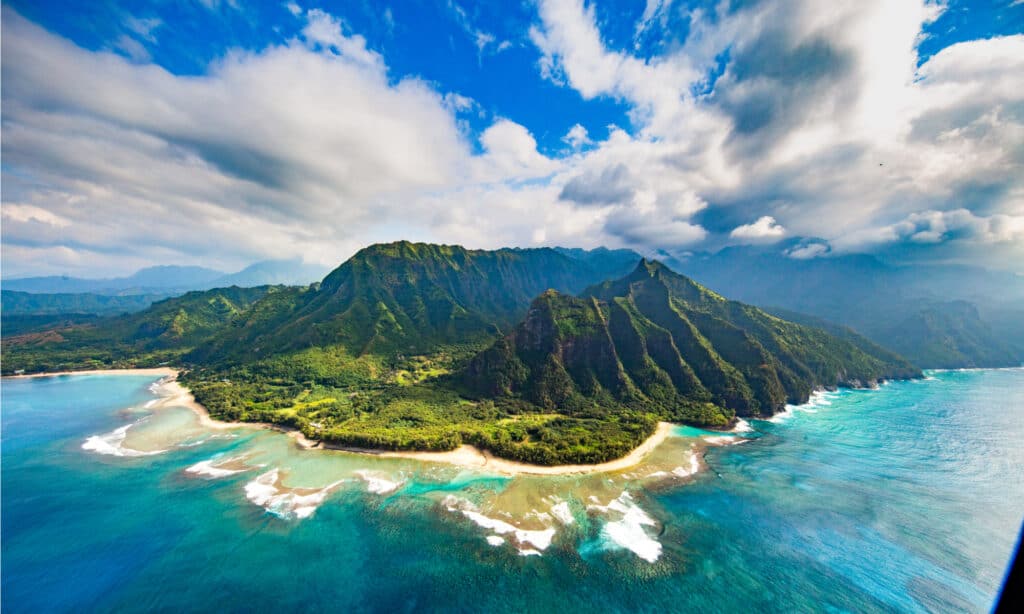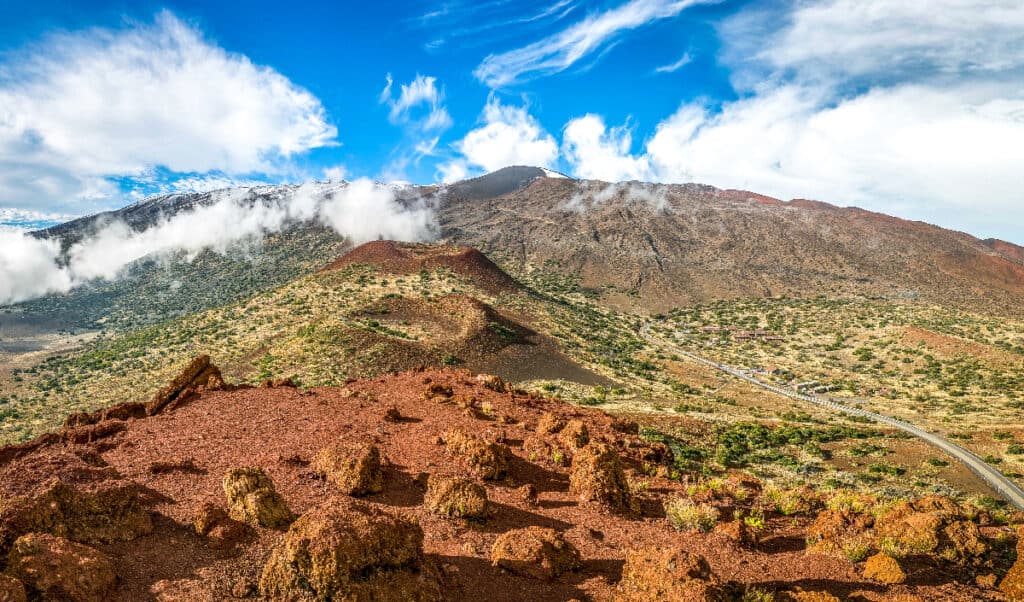Have you ever wondered why the Hawaiian Islands are in a line? They’re a truly amazing series of volcanic islands that perfectly illustrate our Earth’s formation.
The answer to how old are the Hawaiian Islands isn’t straightforward. There are as many answers as there are islands. Some of them aren’t even born yet! Let’s take a look at how and when they formed to find the answers.
How Old Are the Hawaiian Islands?

The first Hawaiian Island emerged about five million years ago.
©Bardocz Peter/Shutterstock.com
The Hawaiian Islands range from 5.1 million years old to .7 million years old. The oldest is Kauai, which is 5.1 million years old while the Big Island rose about .7 million years ago.
As the oldest island, Kauai was the first to emerge from the ocean floor 5.1 million years ago, but others are still forming. Each island has its very own age and story to tell.
The Big Island is the most recent island and it’s still forming new land mass. When a volcano spews out lava it forms new territory there. It’s pretty barren to start with, but over time plants colonize and spread out to create life.
What Are The Hawaiian Islands?
They’re a series of islands that form an archipelago. An archipelago is a chain of islands and the Hawaiian chain stretches for 1,500 miles.
The Islands are actually just the lush green exposed peaks of undersea mountains. The mountain range is called the Hawaiian-Emperor Seamount Chain.
When people refer to ‘Hawaii’ they actually mean the eight main Hawaiian Islands, but there are a large number of other islands too.
These are small bare mountain tops that didn’t grow as large. Incredible coral reefs surround the peaks that just emerge from the water. As do sharks!

Tiger
sharks swim around Hawaiian Island reefs.
©le bouil baptiste/Shutterstock.com
How Were The Hawaiian Islands Formed?
The Hawaiian Islands are formed by volcanoes! Some are extinct, but others such as Big Island are still active. There are new islands forming beneath the surface right now, so a better question is ‘How Are The Hawaiian Islands Formed?’
The Pacific plate moved over a hotspot of lava pouring up from the seabed and over millions of years the lava cooled to create an island.
Then, as the tectonic plate moved, lava built up to make a new island further away. That’s why they’re in a line, moving from east to west, and still moving today.
How Many Hawaiian Islands Are There?
There are eight islands forming the archipelago. Kahoolawe and Niihau are restricted to visitors, but the remaining six are big tourist attractions.
Here are the Hawaiian Islands you can visit:
- Hawaii Island also called Big Island
- Kauai
- Lanai
- Maui
- Molokai
- Oahu
Each island is different, but they all have amazing and clean beaches, sheer cliff faces, and beautiful winter climates.

Hawaiian Islands have vast sandy beaches
©Shane Myers Photography/Shutterstock.com
How Old Is Each Island Of Hawaii?
How old each Hawaiian Island is depends on where it lies in the chain. The islands run in age order from the North-East to South-East. We’ll start with the oldest.
- Kauai 5.1 million years
- Niihau 4.9 million years
- Oahu 2.2 to 3.4 million years
- Molokai 1.3 to 1.9 million years
- Lanai 1.3 million years
- Maui 0.8 to 1.3 million years old
- Kahoolawe 1 million years
- Big Island 0.7 million years up to right now!
Kauai and Niihau are the most eroded because they are the oldest. The process of aging has exposed the cliff faces and landscape so they are craggier than Maui and Big Island.
Where Are The Hawaiian Islands?
The Hawaiian Islands are in the Pacific Ocean 3000 kilometers from the nearest continent. They are the only state that isn’t connected to North America. We could accurately call them the ‘Hawaiian State’.
Instead of the North American mainland, Hawaii is in Oceania. It’s part of the Polynesian Subregion that stretches from Hawaii’s main islands to the Aleutian Trench in the North Pacific.
Will There Be Any More Hawaiian Islands?
Yes, there will be more Hawaiian Islands, but we won’t be around to witness their birth!
A new island is on its way to the South-East of Big Island. It is called Loihi and it’s 3,000 feet below the ocean surface. It’ll peer out sometime between the next 10,000 to 100,000 years!
If you were ever in doubt about the formation of our earth, the Hawaiian Islands are proof!

Hawaiian Islands were made by underwater volcanoes
©Mason Lake Photo/Shutterstock.com
What Is The Hawaiian Hot Spot?
The Hawaiian hot spot refers to the area where lava emerges from the seabed to form underwater volcanoes that grow into the Hawaiian Islands.
The hotspot stays where it is, but the Pacific plate moves. We can trace its course by following the direction of the Hawaiian Islands. The Pacific plate only shifts up to 4 inches a year, but as it moves the islands furthest away become less active due to less magma and heat.
Do you know the difference between magma and lava? Underground molten rock is called magma and when it reaches the surface it’s called lava.
Is It Safe To Visit The Hawaiian Islands?
The eruption temperature of lava on some of the Hawaiian Islands is 1,170 degrees celsius so we can safely say Hawaiian lava is very dangerous! But don’t put your passport away yet.
The Hawaiian archipelago is pretty safe to visit because it is monitored for volcanic activity. Five volcanoes built Big Island and it has four active volcanoes you can see in action today.
The United States Geological Survey (USGS) monitors all volcanoes for changes. You can see the latest worldwide volcanoes and earthquakes here.
What’s the History Of Hawaii?
As well as the fascinating age and formation process Hawaii has some interesting history.
The islands were first settled between 124 AD and 1200 AD by Polynesians (there is still considerable debate around the exact date) and no one else came near for more than 500 years.
The first European to find Hawaii was British explorer James Cook in 1778 although this is disputed by the Spanish who believe Ruy Lopez de Villalobos arrived in 1542.
After Cook’s arrival and loan of weapons, Hawaii Island ruler Kamehameha subdued and unified the island chain. He established the Kingdom of Hawaii in 1795 and it became an important trading spot in the Pacific. American immigrants, Japanese, Chinese, and Filipinos all came to the island not long after.
Perhaps the most famous part of Hawaii’s history is the Pearl Harbor attack on 7th December 1941. Pearl Harbor’s American Airbase was attacked by the Imperial Japanese army killing 2,500 people.
After this, Hawaii was put under martial law and in 1959 Hawaii became the 50th US state after years of treaty negotiation dating back to 1897.
So, the answer to how old are the Hawaiian islands is not at all simple!
Depending on when they formed in the chain they are all different ages. The oldest is 5.1 million years old and the youngest is still forming today. What a range!
The photo featured at the top of this post is © Big Joe/Shutterstock.com
Thank you for reading! Have some feedback for us? Contact the AZ Animals editorial team.






